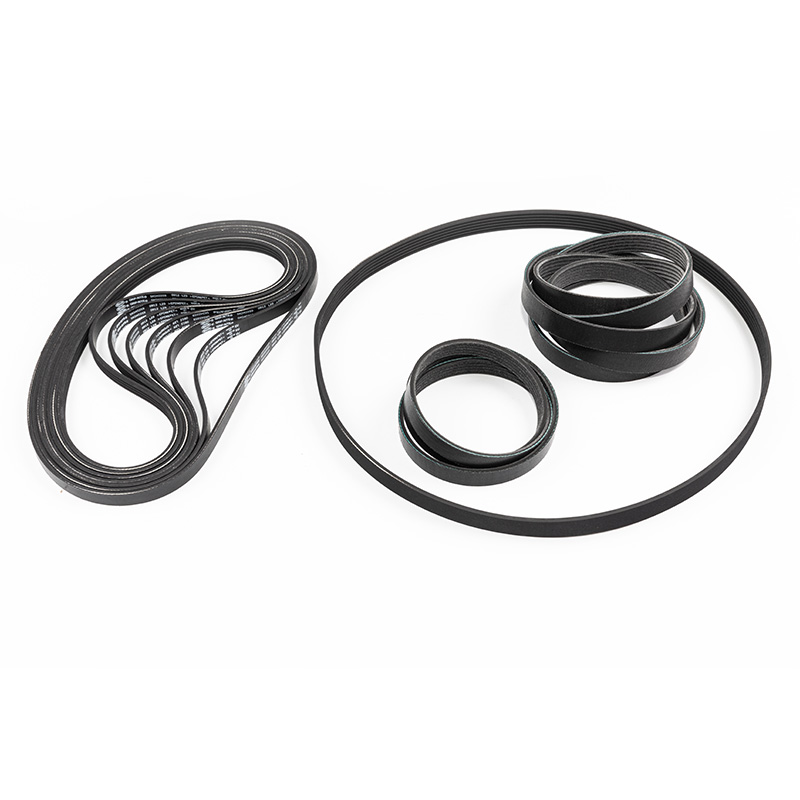Automotive V-Ribbed belts contribute to reducing noise and vibration in several ways:
Damping Properties: The damping properties of V-Ribbed belts stem from the intricate composition of their materials. These belts are typically constructed from a blend of rubber compounds fortified with additives such as carbon black, silica, and other fillers. These additives serve to enhance the belt's ability to absorb and dissipate vibrational energy, acting as molecular shock absorbers within the belt structure. As the engine operates, various mechanical forces induce vibrations that propagate through the belt. The rubber matrix, interspersed with filler particles, undergoes controlled deformation, converting mechanical energy into heat through hysteresis. This dissipation mechanism effectively attenuates vibrations, preventing their transmission to surrounding components and minimizing audible noise.
Smooth Operation: The ribbed design of V-Ribbed belts plays a pivotal role in promoting smooth operation and reducing noise generation. Unlike traditional flat belts, which rely on frictional engagement with pulley surfaces, V-Ribbed belts feature multiple longitudinal ribs that interlock with corresponding grooves on the pulleys. This rib-to-groove interface ensures precise tracking and positive engagement, facilitating smooth motion with minimal slippage. The continuous, uninterrupted contact between the ribs and pulley grooves distributes load forces more evenly, mitigating localized frictional hotspots that can lead to belt squealing or chirping. The ribbed profile minimizes lateral belt movement, preventing oscillations that could otherwise generate unwanted noise and vibration.
Improved Tensioning Systems: Automatic belt tensioners represent a technological advancement that complements the performance of V-Ribbed belts by regulating belt tension dynamically. These tensioners leverage mechanical or hydraulic mechanisms to apply a constant force to the belt, compensating for variations in operating conditions such as temperature changes, belt wear, and engine loads. By actively adjusting belt tension within the optimal operating range, tensioners prevent slack or excessive preload, which can induce belt flapping, resonance, and associated noise. By minimizing belt slip and maintaining optimal grip between the belt and pulleys, tensioners enhance power transmission efficiency while reducing the risk of belt-induced vibrations.
Enhanced Material Composition: The selection of elastomeric materials for V-Ribbed belt construction involves careful consideration of various factors, including tensile strength, abrasion resistance, temperature stability, and flexibility. Modern V-Ribbed belts incorporate advanced elastomers with tailored properties to withstand the demanding conditions encountered in automotive applications. These elastomers exhibit high resilience and fatigue resistance, ensuring prolonged service life under cyclic loading. Strategic reinforcement with aramid fibers, polyester cords, or other high-strength materials enhances belt durability and dimensional stability, thereby minimizing belt elongation and maintaining optimal tension levels. By employing advanced material science principles, V-Ribbed belts achieve a harmonious balance of mechanical properties that optimize noise attenuation and vibration damping characteristics.
Balanced Design: The geometric configuration of V-Ribbed belts is engineered to promote load distribution and mitigate stress concentrations, thereby minimizing the risk of belt-induced vibrations. Each rib of the V-Ribbed belt acts as a load-bearing element, sharing the applied tension forces evenly across the belt width. This distributed loading minimizes localized stress concentrations at rib-pulley interfaces, reducing the likelihood of belt deformation, cracking, or premature failure. The symmetrical arrangement of ribs ensures rotational balance during operation, mitigating centrifugal forces that could induce belt flutter or wobble. As a result, V-Ribbed belts exhibit enhanced dynamic stability and reduced mechanical resonance, contributing to quieter operation and improved overall system performance.
Automotive V-Ribbed Belts



 View More >>
View More >>
 View More >>
View More >>
 View More >>
View More >>
 View More >>
View More >>
 View More >>
View More >>
 View More >>
View More >>
 View More >>
View More >>
 View More >>
View More >>
 View More >>
View More >>
 View More >>
View More >>
 View More >>
View More >>
 View More >>
View More >>